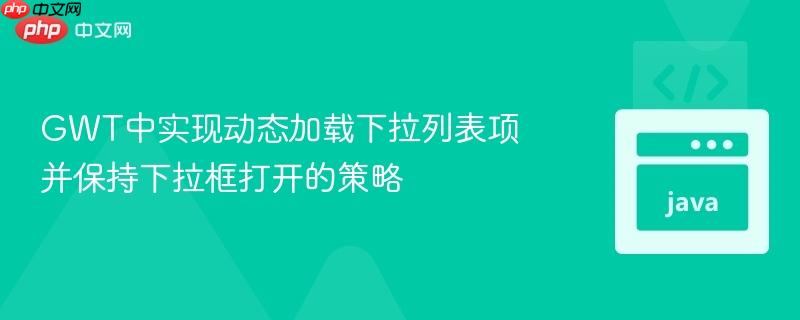
本文探讨了在gwt中实现动态加载下拉列表项,尤其是带有“加载更多”功能时,如何避免下拉框在点击后自动关闭的问题。针对gwt原生listbox的局限性,文章提出并详细阐述了构建自定义下拉组件的解决方案,该方案利用button模拟下拉框外观,并通过popuppanel承载动态加载的列表项,从而实现对组件行为的完全控制。
在GWT(Google Web Toolkit)应用开发中,我们经常需要创建动态加载内容的下拉列表。一个常见的需求是,下拉列表初始显示部分数据,并在列表末尾提供一个“加载更多”选项。当用户点击“加载更多”时,通过异步调用获取更多数据并添加到列表中,同时“加载更多”选项依然保留在列表末尾。然而,使用GWT原生ListBox组件实现此功能时,开发者常会遇到一个问题:当点击“加载更多”选项后,下拉框会自动关闭,这极大地影响了用户体验。
GWT的ListBox组件是对HTML
// 示例:使用ListBox尝试动态加载,但无法阻止下拉框关闭
listBox.addClickHandler(new ClickHandler() {
@Override
public void onClick(ClickEvent event) {
if(listBox.getSelectedItemText().equalsIgnoreCase("Load More...")) {
listBox.removeItem(listBox.getItemCount()-1); // 移除“加载更多”
// 模拟异步加载数据
for(int j = 0; j < 5; j++) {
listBox.addItem("新数据项 " + (listBox.getItemCount() - 1 + j));
}
listBox.addItem("Load More..."); // 重新添加“加载更多”
// 问题:此处下拉框会关闭,用户体验不佳
}
}
});鉴于ListBox的固有局限性,更灵活的解决方案是构建一个自定义的下拉组件。这种方法允许我们完全控制组件的UI、行为以及动态内容加载过程,从而实现点击“加载更多”时下拉框保持打开的需求。
自定义下拉组件的核心思路是:
模拟下拉框的触发器:Button 创建一个Button实例,并为其应用CSS样式,使其看起来像一个标准的下拉框。当用户点击此Button时,我们将控制PopupPanel的显示与隐藏。
// 模拟下拉框的按钮
Button dropdownButton = new Button("请选择...");
dropdownButton.addStyleName("my-custom-dropdown-button"); // 应用自定义CSS承载列表内容的PopupPanelPopupPanel是一个浮动面板,可以根据需要显示和隐藏。它是实现下拉列表的关键。
final PopupPanel popup = new PopupPanel(true); // true表示点击PopupPanel外部时自动隐藏
popup.addStyleName("my-custom-dropdown-popup"); // 应用自定义CSSPopupPanel内部的列表容器 在PopupPanel内部,我们需要一个面板来按顺序排列列表项和“加载更多”按钮。VerticalPanel是一个不错的选择,因为它能垂直堆叠子组件。为了支持滚动,可能需要将VerticalPanel放入一个ScrollPanel中。
final VerticalPanel itemListPanel = new VerticalPanel();
itemListPanel.addStyleName("my-custom-dropdown-list"); // 应用自定义CSS
// 如果列表项很多,可能需要滚动条
ScrollPanel scrollPanel = new ScrollPanel(itemListPanel);
scrollPanel.setHeight("200px"); // 设置固定高度,超出则滚动
popup.setWidget(scrollPanel);动态添加列表项与“加载更多”按钮 列表项可以是Label、Anchor或自定义的Widget。每个列表项都应该有自己的ClickHandler来处理选中逻辑。在列表的末尾,添加一个独立的“加载更多”Button。
// 初始加载数据
private void loadInitialItems(VerticalPanel panel) {
for (int i = 0; i < 10; i++) {
addItem(panel, "初始数据项 " + i);
}
addLoadMoreButton(panel);
}
private void addItem(VerticalPanel panel, String text) {
final Label item = new Label(text);
item.addStyleName("my-custom-dropdown-item");
item.addClickHandler(event -> {
dropdownButton.setText(item.getText()); // 更新模拟下拉框的显示
popup.hide(); // 选中后关闭PopupPanel
});
panel.add(item);
}
private void addLoadMoreButton(VerticalPanel panel) {
final Button loadMoreBtn = new Button("加载更多...");
loadMoreBtn.addStyleName("my-custom-dropdown-load-more");
loadMoreBtn.addClickHandler(event -> {
// 异步加载更多数据
// 模拟异步调用
new Timer() {
@Override
public void run() {
panel.remove(loadMoreBtn); // 移除旧的“加载更多”按钮
for (int i = 0; i < 5; i++) {
addItem(panel, "更多数据项 " + (panel.getWidgetCount() - 1 + i));
}
addLoadMoreButton(panel); // 重新添加“加载更多”按钮到末尾
// 关键:PopupPanel不会关闭
}
}.schedule(500); // 模拟500ms延迟
});
panel.add(loadMoreBtn);
}关联触发器与PopupPanel 为dropdownButton添加ClickHandler,在点击时显示或隐藏PopupPanel。PopupPanel的显示位置可以根据dropdownButton来确定。
dropdownButton.addClickHandler(event -> {
if (!popup.isShowing()) {
// 在按钮下方显示PopupPanel
popup.setPopupPositionAndShow((offsetWidth, offsetHeight) -> {
int left = dropdownButton.getAbsoluteLeft();
int top = dropdownButton.getAbsoluteTop() + dropdownButton.getOffsetHeight();
popup.setPopupPosition(left, top);
});
} else {
popup.hide();
}
});import com.google.gwt.core.client.EntryPoint;
import com.google.gwt.user.client.Timer;
import com.google.gwt.user.client.ui.*;
import com.google.gwt.event.dom.client.ClickHandler;
import com.google.gwt.event.dom.client.ClickEvent;
public class CustomDropdown implements EntryPoint {
private Button dropdownButton;
private PopupPanel popup;
private VerticalPanel itemListPanel;
@Override
public void onModuleLoad() {
// 1. 模拟下拉框的触发器
dropdownButton = new Button("请选择...");
dropdownButton.addStyleName("my-custom-dropdown-button");
// 2. 承载列表内容的PopupPanel
popup = new PopupPanel(true); // true: 点击外部自动隐藏
popup.addStyleName("my-custom-dropdown-popup");
// 3. PopupPanel内部的列表容器
itemListPanel = new VerticalPanel();
itemListPanel.addStyleName("my-custom-dropdown-list");
ScrollPanel scrollPanel = new ScrollPanel(itemListPanel);
scrollPanel.setHeight("200px"); // 设置固定高度,超出则滚动
scrollPanel.setWidth("180px"); // 设置宽度
popup.setWidget(scrollPanel);
// 4. 初始加载数据和“加载更多”按钮
loadInitialItems(itemListPanel);
// 5. 关联触发器与PopupPanel
dropdownButton.addClickHandler(event -> {
if (!popup.isShowing()) {
popup.setPopupPositionAndShow((offsetWidth, offsetHeight) -> {
int left = dropdownButton.getAbsoluteLeft();
int top = dropdownButton.getAbsoluteTop() + dropdownButton.getOffsetHeight();
popup.setPopupPosition(left, top);
});
} else {
popup.hide();
}
});
// 将自定义下拉组件添加到页面
RootPanel.get().add(dropdownButton);
}
// 辅助方法:加载初始列表项
private void loadInitialItems(VerticalPanel panel) {
for (int i = 0; i < 5; i++) {
addItem(panel, "初始数据项 " + i);
}
addLoadMoreButton(panel);
}
// 辅助方法:添加单个列表项
private void addItem(VerticalPanel panel, String text) {
final Label item = new Label(text);
item.addStyleName("my-custom-dropdown-item");
item.setWidth("100%"); // 让item充满父容器宽度
item.addClickHandler(event -> {
dropdownButton.setText(item.getText()); // 更新模拟下拉框的显示文本
popup.hide(); // 选中后关闭PopupPanel
});
panel.add(item);
}
// 辅助方法:添加“加载更多”按钮
private void addLoadMoreButton(VerticalPanel panel) {
final Button loadMoreBtn = new Button("加载更多...");
loadMoreBtn.addStyleName("my-custom-dropdown-load-more");
loadMoreBtn.setWidth("100%"); // 让按钮充满父容器宽度
loadMoreBtn.addClickHandler(event -> {
// 模拟异步加载更多数据
new Timer() {
@Override
public void run() {
// 移除旧的“加载更多”按钮
panel.remove(loadMoreBtn);
// 添加新数据
int currentCount = panel.getWidgetCount(); // 不包含刚移除的loadMoreBtn
for (int i = 0; i < 5; i++) {
addItem(panel, "更多数据项 " + (currentCount + i));
}
// 重新添加“加载更多”按钮到末尾
addLoadMoreButton(panel);
// 此时PopupPanel保持打开状态
}
}.schedule(500); // 模拟500ms延迟
});
panel.add(loadMoreBtn);
}
}尽管GWT的ListBox组件简单易用,但其基于原生HTML
以上就是GWT中实现动态加载下拉列表项并保持下拉框打开的策略的详细内容,更多请关注php中文网其它相关文章!

每个人都需要一台速度更快、更稳定的 PC。随着时间的推移,垃圾文件、旧注册表数据和不必要的后台进程会占用资源并降低性能。幸运的是,许多工具可以让 Windows 保持平稳运行。

Copyright 2014-2025 https://www.php.cn/ All Rights Reserved | php.cn | 湘ICP备2023035733号